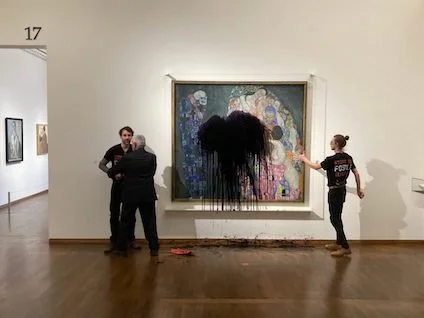Damaging Art in the Name of Activism
I’ve been reading about climate activists attempting to damage major artwork to convey their growing distress about the global environmental crisis. I am definitely in favor of doing everything we can ecologically to forestall the dire situation of our planet. However, I question disfiguring renowned art pieces as tools to get attention. It feels destructive rather than productive. Here’s what’s been reported.
Self-Portrait (1889), by Vincent van Gogh. Paris, Musée d’Orsay. Source: commons.wikimedia.org/
Guards at the Musée d’Orsay in Paris were able to prevent a Just Stop Oil protestor from gluing and souping Van Gogh’s Self-portrait (in Saint Remy) last October when they noticed the protester remove her sweater to reveal Just Stop Oil’s signature white shirt beneath. But other artwork has not escaped such notorious handiwork.
Two activists in front of Horse and Rider (2014), by Charles Ray. Paris. Source: derniererenovation.fr/nos-actions/
Last November, in central Paris, environmental activists dumped orange paint over an outdoor sculpture by contemporary American artist Charles Ray. It was yet another defacement made to encourage greater government efforts to fight climate change. Lifesize, Horse and Rider is located in front of the Bourse de Commerce art museum. Dernière Renovation ("Last Renewal") claimed responsibility. On their website is the above photo, showing two activists kneeling and holding hands in front of the paint-splashed sculpture, which also sports a white T-shirt over the rider with the words "We have 858 days left." The sentence refers to studies indicating that, if the planet is to have a viable future, carbon emissions must peak by 2025. Art restorers quickly intervened and cleaned the sculpture the same day.
Two activists slosh a painting by Klimt with “a black, oily liquid” at the Leopold Museum, Vienna. Photo courtesy of Letzte Generation Österreich. Source: news.artnet.com/art-world/
Also that November, but this time in Vienna, two activists from the German group Letzte Generation (“Last Generation”) entered the Leopold Museum and threw “a black, oily liquid” at the protective glass that covers Death and Life, by Austrian painter Gustav Klimt (1862-1918). The glass prevented the work from getting damaged, but it and the surrounding floor and wall needed to be cleaned. Police removed the individuals when they attempted to glue themselves to the glass. The culture ministers of both France and Austria, respectively, Rima Abdul-Malak and Andrea Mayer, stated: “Art and ecology are not mutually exclusive. On the contrary, they are common causes!” “Art and culture are allies in the fight against climate catastrophe.”
Tod und Leben (Death and Life), 1910/1915, by Gustav Klimt. Vienna, Leopold Museum. Source: commons.wikimedia.org/
These are only a few examples of many that have arisen at different museums and galleries, and not just in Europe but also in North America. In another instance, pea soup was spilled on Vincent van Gogh’s The Sower at Sunset, when it was on display at the Palazzo Bonaparte in Rome, on loan from the Netherlands’s Kröller-Müller Museum. Glass prevented the painting from getting marred.
The Sower at Sunset (1888), by Vincent van Gogh. Source:commons.wikimedia.org/
In Berlin, a protestor, without links to any of the organizations cited previously, splattered fake blood on Clown, a work by French artist Henri Toulouse-Lautrec (1864-1901), and glued his hand to the wall at the Alte Nationalgalerie.
Clown (ca. 1886-87), by Henri Toulouse-Lautrec. Berlin, Alte Nationalgalerie.
Source: commons.wikimedia.org/
At the Museum Barberini in Potsdam, Germany, two Letzte Generation activists tossed buckets of mashed potatoes on Haystacks, by French artist Claude Monet (1840-1926). They also each glued a hand to the wall around the work and proceeded to give a speech about our climate crisis, though those in the gallery scorned them. Both were taken to jail. Fortunately, the painting was not damaged, but the museum was closed for the following week. All the protesters had managed to do was keep visitors from viewing art.
Haystacks (1890), by Claude Monet. Private Collection.
Source: commons.wikimedia.org/
Also last autumn, two women from Just Stop Oil went to the National Gallery in London, where they tossed tomato soup at van Gogh’s Sunflowers (1888). I could cite many more events from last year and additional ones occurring this year (including at the National Gallery in Washington, D.C. and Canada), but you get the picture of what’s going on. If you’re interested in learning more about them, here are two links: Artnet and The New York Times.
Sunflowers (1888), by Vincent van Gogh. National Gallery, London. Source: commons.wikimedia.org/
I am left with questions: How would damaging revered artwork encourage government leaders to act faster about climate issues? And why choose art to get your message across? Artists already create works that signal the environmental crisis. How do attempts to deface what people are drawn to visit at home or in their travels win hearts and minds? There is a price paid for the damage made. Art institutions are, basically, not-for-profit organizations. Each time an artwork or its site has to be cleaned or repaired is costly. Each time more security personnel have to be hired is costly. The biggest cost, of course, is what we’re inflicting on the planet. But using art the way protesters are using it strikes me as not the way to go about creating lasting change.
Comments & Questions:
How is art a vehicle for communicating important information?
How can we constructively raise awareness about environmental problems without hurting artwork?







